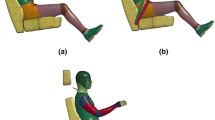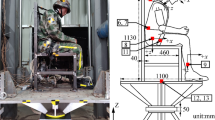Abstract
Occupant injury from rear end impact is rapidly becoming one of the most aggravating traffic safety problems with high human suffering and societal costs. Although rear end impact occurs at a relatively low speed, it may cause permanent disability due to neck injuries resulting from an abrupt moment, shear force, and tension/compression force at the occipital condyles. The analysis is performed for a combined occupant-seat model response, using the SAFE (Safety Analysis For occupant crash Environment) computer program. A simulation model is established to match the sled tests. A parameter study is conducted for various physical and mechanical properties. Seat design has been carried out based on the design of experiment (DOE) process with respect to five parameters: seat back collapse angle, joint stiffness between the seat back and seat cushion, headrest stiffness, the clearance between the occupant's head and headrest, and friction coefficient of the seat back. An orthogonal array is employed for the DOE. A good design has been found from the results of the experiment. It is found that reductions of the seat back collapse angle and joint stiffness are the most effective for preventing neck injuries.
Similar content being viewed by others
REFERENCES
WU, P, SHANMUGAVELU, I, MONDEAU, S, KANT, R. "Improved Seat & Manniken Models to Study Rear Impact Protection," 1998.
STATES, J D. "Soft Tissue Injuries of the Neck," SAE Paper No. 790135, 1979.
DIGGES, K H, MORRIS, J H and MALLIARIS, A C. "Safety Performance of Motor Vehicle Seats," SAE Paper No. 930348, 1993.
WARNER, C Y, STOTHER, C E, JONES, M B and DECKER, R L. "Occupant Protection in Rear-End Collision?: The Role of Seat Back Deformation in Injury Reduction," SAE Paper No. 912914, 1991.
PARK, Y S, LEE, J Y, LIM, J M and PARK, G J. "Optimum design of a steering column to minimize the injury of a passenger," International Journal of Vehicle Design, Vol. 17, No. 4, pp. 398-414, 1996.
LIM, J M, CHOI, J W and PARK, G J. "Automobile side impact modeling using ATB software," International Journal of Crashworthiness, Vol. 2, No. 3, pp. 287-297, 1997.
OBERGEFELL, L A, GARDNER, T R, KALEPS, I and FLECK, J T. "Articulated Total Body Model Enhancements," Report No. AAMRL-TR-88-043, 1988.
FLECK, J T and BUTTLER, F E. "Validation of the Crash Victim Simulator," Report No. DOT HS-806279, 1981.
JAMES, M, NORDHAGAN, R, WARNER, C, ALLSOP, D and PERI, T. "Limiations of ATB/CVS as an Accident Reconstruction Tool," SAE Paper No. 971045, 1997.
PRASAD, P and CHOU, C C. "A Review of Mathematical Occupant Simulation Models. Crashworthiness and Occupant Protection in Transportation Systems," ASME, AMD-Vol. 106, BED-Vol. 13, pp. 95-11.
SAFE User's Manual, Hanyang University, 1999.
PRASAD, P, KIM, A and WEERAPPULI, D P V. "Biofidelity of Anthropomorphic Test Devices for Rear Impact," SAE Paper No. 973342, 1997.
PEACE, G S. "Taguchi Methods (A Hands-On Approach)," Addison-Wesley Publishing Company, Inc., Singapore, 1992.
PHADKE, M S. "Quality Engineering Using Robust Design," Prentice Hall, New Jersey, 1989.
BOSIO, A C and LUPKER, H A. "Design of Experiments in Occupant Simulation," SAE Paper No. 910891, 1991.
DICKSON, K R and AFZAL, N. "Airbag Restraint System Design by Crash Simulation Modeling and Design of Experiments," SAE Paper No. 901718, 1990.
GEBOD User's Manual, AL/CF-TR-1994-0051, 1994.
ROBERTS, V L and COMPTON, C P."The Relationship Delta V and Injury," SAE Paper No. 933111, 1993.
PRASAD, P, KIM, A, WEERAPPULI, D P V, ROBERTS, V and SCHNEIDER, D, "Relationships Between Passenger Car Seat Back Strength and Occupant Injury Severity in Rear End Collisions: Field and Laboratory Studies," SAE Paper No. 973343, 1997.
WATTS, A J, ATKINSON, D R and HENNESSY, C J. "Speed Automobile Accidents: Accidents Reconstruction and Occupant Kinematics, Dynamics and Biomechanics," Lawyers & Judges Publishing Company, Inc., 1996.
MERTS, H J and PATRICK, L M. "Investigation of the Kinematics and Kinetics of Whiplash," SAE Transactions, Vol. 76, SAE Technical Paper No. 670919, Society of Automotive Engineers, Warrendale, PA, 1967.
MERTZ, H J and PATRICK, L M. "Strength and Response of the Human Neck," SAE Paper No. 710855, 1971.
DOT 49 CFR Parts 571, 585, 587, and 595 Docket No. NHTSA 98-4405; Notice 1 RIN 2127-AG70. Federal Motor Vehicle Safty Standards; FMVSS 208: Occupant Crash Protection. 1998.
KLEINBERGER, M, SUN, E. et al., "Development of Improved Injury Criteria for the Assessment of Advanced Automotive Restraint Systems," NHTSA, Sept., 1998.
Rights and permissions
About this article
Cite this article
Shin, M.K., Park, K.J. & Park, G.J. Occupant analysis and seat design to reduce neck injury from rear end impact. International Journal of Crashworthiness 8, 573–581 (2003). https://doi.org/10.1533/ijcr.2003.0260
Issue Date:
DOI: https://doi.org/10.1533/ijcr.2003.0260




